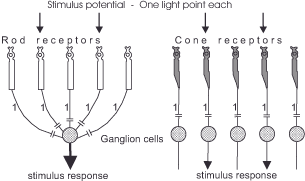You are here: Nature Science Photography – Visual acuity – The resolving power of the visual system
In addition to their distribution on the retina, photoreceptors exhibit differences in their circuitry with downstream neurons, a factor that also influences visual acuity. From front to back, the approximately 120 million photoreceptors gradually reduce their signal amount and merge with the 1 million ganglion cells, the extension of which leads out of the eye as the optic nerve. Due to the larger quantity, an average of 120 rods and only six cones converge in each ganglion cell. Considering that many cone cells of the optic pit exclusively connect to one ganglion cell, this discrepancy becomes even more significant.
Figure 9 (Neuronal wiring and visual acuity) illustrates the practical effect of convergence. The visual system can’t figure out that there are two separate light stimuli based on how the two rod receptors are excited and how the ganglion cell responds to them, since they converge with three other cells. On the other hand, the cone receptors of the fovea centralis exclusively connect to one ganglion cell each, leading to the perception of a stimulus response from two separate receptors.

Next The quality of ophthalmic optics
Main Visual acuity
Previous The arrangement of photoreceptors on the retina
If you found this post useful and want to support the continuation of my writing without intrusive advertising, please consider supporting. Your assistance goes towards helping make the content on this website even better. If you’d like to make a one-time ‘tip’ and buy me a coffee, I have a Ko-Fi page. Your support means a lot. Thank you!


 Since I started my first website in the year 2000, I’ve written and published ten books in the German language about photographing the amazing natural wonders of the American West, the details of our visual perception and its photography-related counterparts, and tried to shed some light on the immaterial concepts of quantum and chaos. Now all this material becomes freely accessible on this dedicated English website. I hope many of you find answers and inspiration there. My books are on
Since I started my first website in the year 2000, I’ve written and published ten books in the German language about photographing the amazing natural wonders of the American West, the details of our visual perception and its photography-related counterparts, and tried to shed some light on the immaterial concepts of quantum and chaos. Now all this material becomes freely accessible on this dedicated English website. I hope many of you find answers and inspiration there. My books are on